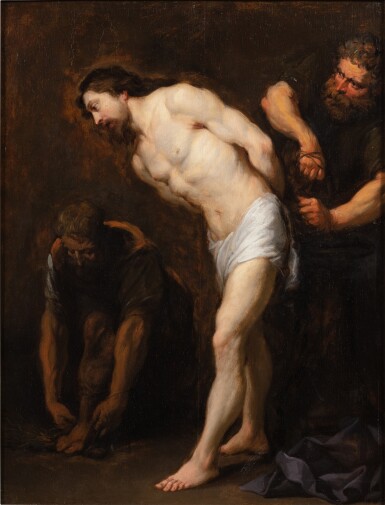Tableaux Dessins Sculptures 1300-1900
Tableaux Dessins Sculptures 1300-1900

Property from the Estate of Alexis Gregory, sold to Benefit the Alexis Gregory Foundation | Provenant de la succession Alexis Gregory, vendu au profit de la Fondation Alexis Gregory
After Gérard Seghers | D'après Gérard Seghers
Christ at the column | Le Christ à la colonne
Lot Closed
November 10, 02:17 PM GMT
Estimate
6,000 - 8,000 EUR
Lot Details
Description
After Gérard Seghers
Christ at the column
Oil on panel
64,5 x 50 cm ; 25 ⅜ by 19 ¾ in.
____________________________________________
D'après Gérard Seghers
Le Christ à la colonne
Huile sur panneau
64,5 x 50 cm ; 25 ⅜ by 19 ¾ in.
This painting may be compared with Preparations for the Flagellation of Christ by Gerard Seghers. Produced for the church of Saint-Michel de Gand, the composition was disseminated in an engraving by Lucas Vorsterman (ill. 1; Rijksmuseum, Amsterdam, inv. RP-P-OB-33.014). The author of this painting was clearly inspired by the print: he has shown the same two torturers in the background, but above all he has reflected the composition’s theatricality, created through the play of shadow and light and given further emphasis by the tight framing. Christ’s pale, luminous flesh tones contrast with the brown background as well as with the ruddier complexions of the torturers, giving the divine figure a monumental quality.
However, this is not an exact copy: the movement of Christ’s torso recalls the Flagellation of Christ by Caravaggio, now in the Musée des Beaux-Arts in Rouen (inv. 955.8.1). This exaggerated torsion also adds to the power of the composition, reinforcing its dramatic character.
Skilfully combining Flemish tradition with the Italian manner, the present painting attests to the wealth of artistic exchanges and the spread of Caravaggesque models in Flanders during the seventeenth century.
____________________________________________
Le présent tableau est à rapprocher des Préparatifs de la Flagellation du Christ de Gerard Seghers. Réalisé pour l’église Saint-Michel de Gand, sa composition circula par le biais d’une gravure de Lucas Vorsterman (ill. 1 ; Rijksmuseum, Amsterdam, inv. RP-P-OB-33.014). L’auteur de notre tableau s’en est inspiré de façon évidente : l’on y retrouve les deux bourreaux en arrière-plan, mais surtout la théâtralité de la composition transmise par les jeux d’ombre et de lumière, accentuée encore par le cadrage serré. La blancheur lumineuse des chairs du Christ contraste avec les fonds bruns ainsi qu’avec les carnations plus rouges des bourreaux en arrière-plan, monumentalisant ainsi la figure divine.
Il ne s’agit cependant pas ici d’une copie exacte : le mouvement du torse du Christ reprend celui que l’on observe dans la Flagellation du Christ du Caravage, aujourd’hui conservée au musée des Beaux-Arts de Rouen (inv. 955.8.1). Cette torsion exagérée rajoute elle aussi de la force à la composition, et renforce son caractère dramatique.
Habile conjugaison de la tradition flamande avec la manière italienne, notre tableau témoigne de la richesse des échanges artistiques et de la diffusion des modèles caravagesques en Flandres au XVIIe siècle.
